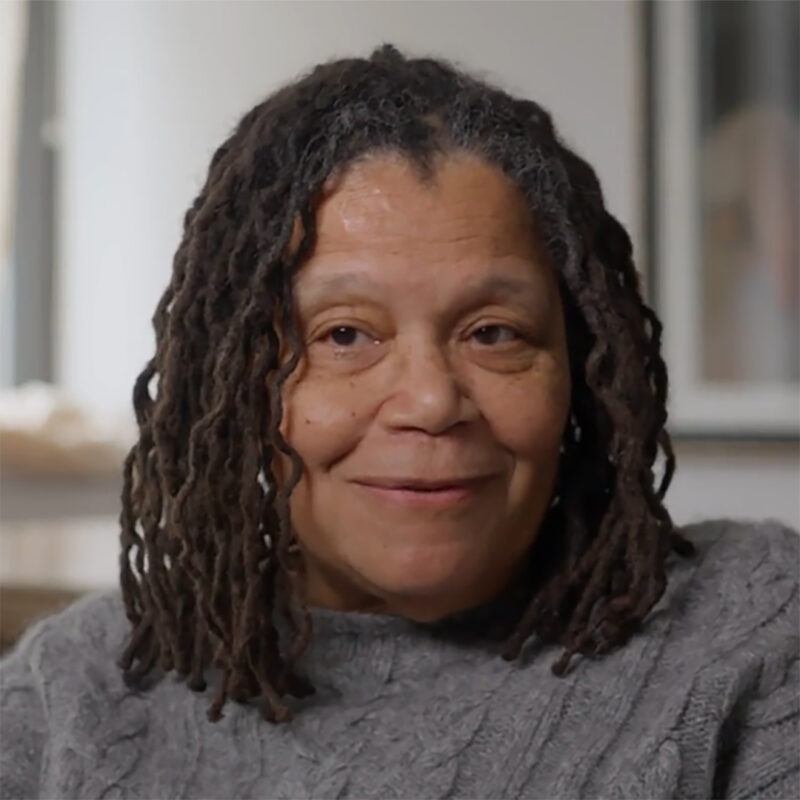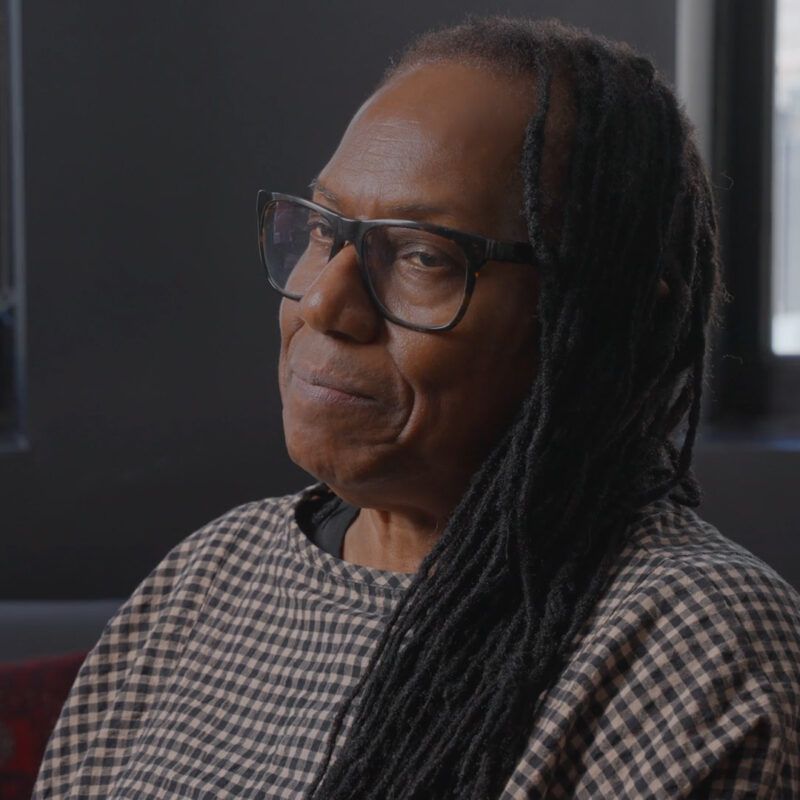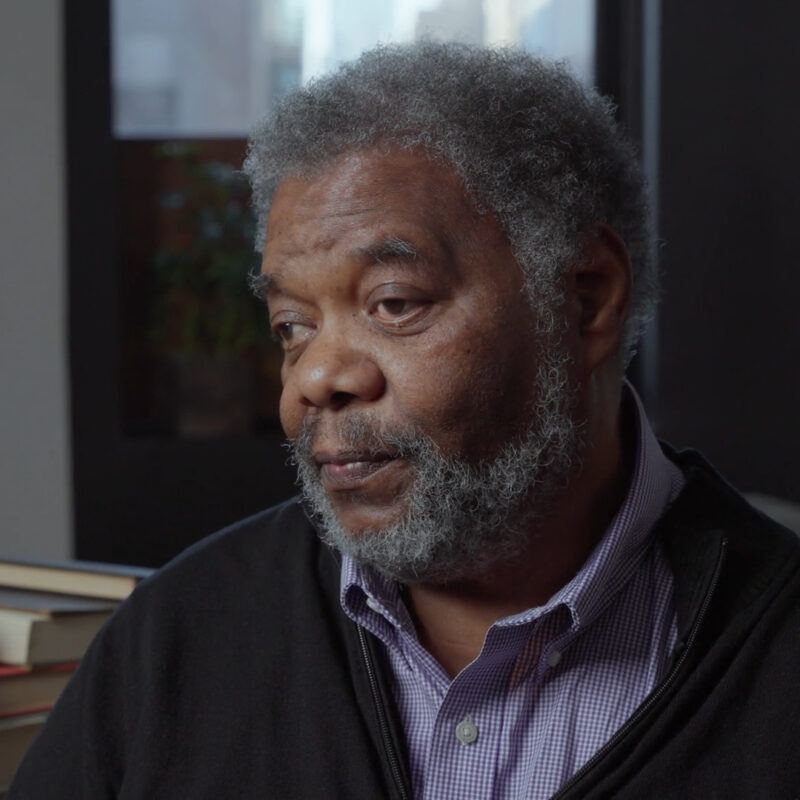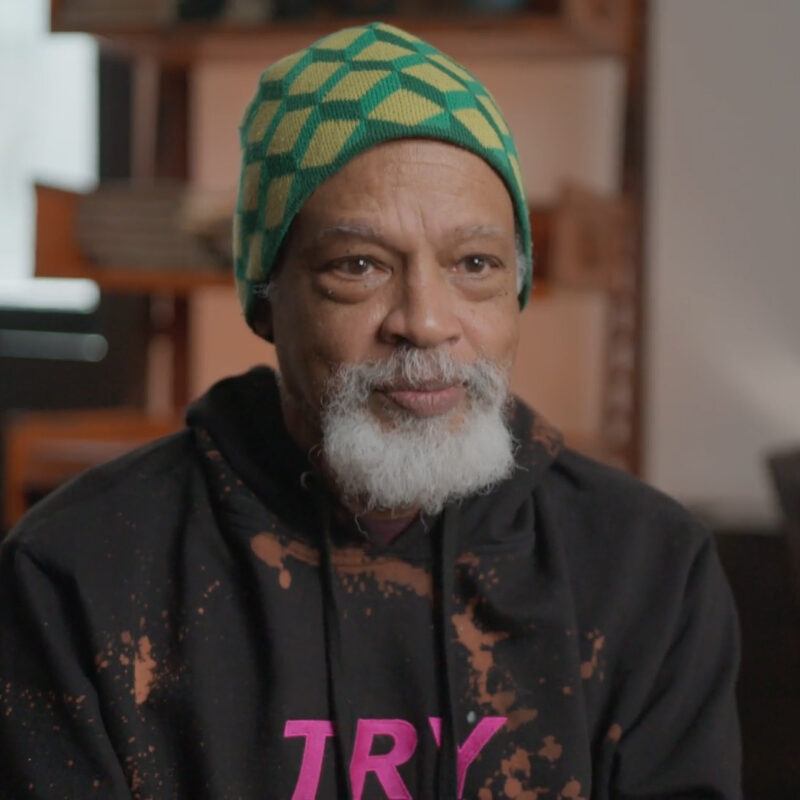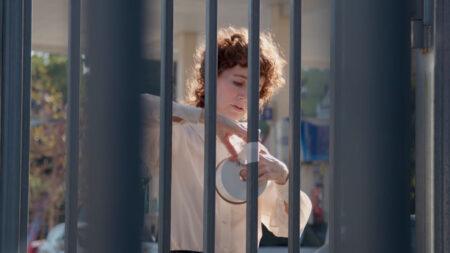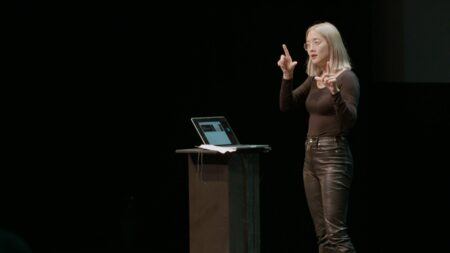Continue playing
(Time remaining: )
Play from beginning
Continue playing "{{ controller.videos[controller.getVideo(controller.currentVideo)].segmentParentTitle}}"
{{controller.videos[controller.getVideo(controller.currentVideo)].title}} has ended.
Linda Goode Bryant in “Friends & Strangers”
Descriptive audio version available here.
Visit our Awards page for this film’s honors and recognition.
Standing amid brick buildings and concrete roads, artist Linda Goode Bryant works the land, supplying underserved communities with plant-based food through Project EATS, which she founded. Her work in institution-building began long before Project EATS. In 1972, the artist moved to New York City and began working at the Studio Museum in Harlem, where she spoke to Black artists who continually expressed feeling shut out of the art world. In response, Goode Bryant said, “Let’s just do it ourselves,” and the Just Above Midtown (JAM) gallery emerged from that decision. Committed to showing the work of Black artists and other artists of color alongside white artists, the gallery aimed not to replicate the discrimination of other institutions at the time. Choreographing the community that gathered at JAM was a part of Goode Bryant’s artistic practice, bringing artists from across the city and the country to participate in the project, like New York City–based artists Janet Olivia Henry and Randy Williams and West Coast artists Senga Nengudi, Houston Conwill, and David Hammons. Goode Bryant made a space for experimentation in Black and contemporary art and became home to vital conversations, like the explosive opening of David Hammons’s Greasy Bags and Barbeque Bones at JAM.
Artist Maren Hassinger recollects that money was not the objective at JAM, but instead, the goal was that artists would make new and extraordinary work. The community gathered at JAM catalyzed artists to develop new and better art, as observed by artist and choreographer Ishmael Houston-Jones. Currently, Goode Bryant leads Project EATS, a New York City–based urban farming nonprofit with six farms growing plant-based food for communities without access to locally grown foods. At Project EATS, communities gain access to produce and learn how to farm themselves. Forty years after JAM first opened, Just Above Midtown: Changing Spaces opened at the Museum of Modern Art. The exhibition charts the sixteen years JAM was open, bringing together a suite of groundbreaking works exhibited at JAM and working to bring its radical spirit into the institution. “I could really, really, really look up and see the elders sitting in the rafters and say, ‘Y’all did it. We’re here. We’re in the infrastructure of this mofo now.’ And I like that.” says Goode Bryant. “Because we should be. We should’ve been. And we are.”
Credits
Executive Producer: Tina Kukielski. Series Producer: Nick Ravich. Director: Chiemi Karasawa. Editors: Mary Ann Toman, Lynn True. Cinematography: Sam Cullman. Archival Producer: Leah Ford. Associate Producer: Andrea Chung. Assistant Curator: Jurrell Lewis. Design & Animation: Ryan Carl, Nikita Iziev. Composer: Andrew Orkin. Additional Photography: Nick Curran, Jane Macedo Yang, Carla Mejia. Assistant Camera: Isa Fernandez, Bailey Lica, Colin Morris. Location Sound: Genna Edwards, Robert La Rosa, Steve Lopez, Fiona Mcbain, Eric Perez. Advising Producer: Ian Forster.
Additional Art21 Staff: Lauren Barnett, Hannah Degarmo, Lolita Fierro, Joe Fusaro, Molaundo Jones, Emma Nordin, Anna Pruett, Jessica Svenson, Noor Tamari, Nora Wimmer.
Production Assistant: Danica Drezner. Video Post-Production Services: Cut + Measure. Video Post-Production Producer: Alex Laviola. Colorist: Chris Ramey. Online & Conform: David Gauff. Additional Video Editors: Addison Post, Adam Varca. Additional Animation: Andy Cahill. Audio Post-Production Sound Services: Konsonant Post. Re-Recording Mixer: Gisela Fullà-Silvestre. Sound Editor: Ben Kruse. Assistant Editors: Ellen Askey, Stephanie Cen, Michelle Hanks. Additional Research: Susan Thompson. Station Relations: De Shields Associates. Legal Counsel: Franklin Weinrib Rudell + Vassallo.
Interns: Stephanie Ades, Sekou Cherif, Yeon Cho, Michaela Esteban, Emma Flood, Amber He, Emma Kanne, Carina Martinez, Renee Rienecker, James Santiago, Dani Wieder.
Artwork Courtesy: Linda Goode Bryant; Willie Birch, “Woman Feeding Child” (1983), Part Of The “Solid State Series;” Elizabeth Catlett, © 2023 Mora-Catlett Family / Licensed By Vaga At Artists Rights Society (Ars), NY; Valerie Maynard, © 2023 Estate Of Valerie J. Maynard / Artists Rights Society (Ars), New York; Betye Saar, “Fragments” (1976) / Courtesy Of The Artist And Roberts Projects, Los Angeles.
Archival Materials: African American Performance Art Archive, American Museum Of Folk Art, Baltimore Museum Of Art, Adam Avila, Dawoud Bey, Sydney Blum, Dwight Carter, Elizabeth Catlett, Charles White Archives, Barbara Chase-Riboud, Coreen Simpson Photography, Krista Dibernardo-Williams, Austin Donohue, Meg Eginton, Estate Of Houston Conwill, Robert Gerhardt, David Hammons, Hatch Billops Collection, Hauser & Wirth, Palmer Hayden, Jane Comfort And Company, Dr. Kellie Jones, Philip Mallory Jones, Kinolibrary, George Klass, La Modern, Lawrence D. Morris Estate, Lorna Simpson Studio, Mark Liflander, Jeff Morgan, The Museum Of Modern Art, Senga Nengudi, Nys Office Of General Services, Harmon Outlaw, Herb Perr, Rago/Wright, Mallica “Kapo” Reynolds, Ryan Lee Gallery, Sean Kelly, New York, The Studio Museum In Harlem Archives, Susan Inglett Gallery, Russ Thompson, Vaga/Ars, Doug Vann, Wendy Ward Elhers, Faythe Weaver, John Wronn.
Special Thanks: The Art21 Board Of Trustees, Susan Block, Laura Coxson, Ramon Ariel De Los Santos, Michelle Elligott, Maren Hassinger, Janet Olivia Henry, Ishmael Houston-Jones, Marielle Ingram, Keith Jackson, T Lax, Media Mavens, Meg Montgoris, Sam Nichols, Jared Michael Nickerson, Cole Palatini, Ryan Pattie, Project EATS, Randy Williams.
Major underwriting for Season 11 of Art in the Twenty-First Century is provided by PBS, National Endowment for the Arts, Lambent Foundation, The Anna-Maria and Stephen Kellen Foundation, The Andy Warhol Foundation for the Visual Arts, The Horace W. Goldsmith Foundation, Toby Devan Lewis, Robert Lehman Foundation, and Nion McEvoy & Leslie Berriman.
Series Creators: Susan Dowling and Susan Sollins.
©2023 Art21, Inc.
Closed captionsAvailable in English, German, Romanian, Italian, Japanese, Korean, Chinese, Italian
Through the Art21 Translation Project, multilingual audiences from around the globe can contribute translations, making Art21 films more accessible worldwide.
Interested in showing this film in an exhibition or public screening? To license this video please visit Licensing & Reproduction.
Linda Goode Bryant was born in 1949 in Columbus, Ohio, and currently lives and works in New York City, New York. In 1972, Goode Bryant received her BA from Spelman College in Atlanta, Georgia, and studied art history at the City College of New York until 1974, later receiving her MBA from Columbia University in 1980. In the many different titles and hats that the artist has worn throughout her decades-long career, including educator, gallerist, activist, filmmaker, and farmer, Goode Bryant has sought to realize ideas that were previously thought impossible through a choreography of passion, commitment, skill, and community. From creating the first Black commercial gallery in New York City to founding an urban farming nonprofit on concrete yards and city rooftops, Goode Bryant’s works empower communities and create tangible change, allowing others to realize their impossible ideas alongside her.
Janet Olivia Henry was born in 1947 in New York City, New York, where currently she lives and works. Henry attended the School of Visual Arts from 1964 to 1965 and later received her Associate Degree from the Fashion Institute of Technology in 1969. The artist’s work in collage and assemblage draws from American culture, using images from magazines, dolls, and objects produced in miniature to create connections and juxtapositions. Her work frequently draws from and comments on her experiences, as in The Studio Visit (1983), where the artist stages the scene of a studio visit in miniature. In The Studio Visit, a Barbie Star Trek Lieutenant Uhura doll, a recurring material in Henry’s work, sits beside a smaller, white doll who is literally framed within the diorama, pointing to the centrality of a white, outside perspective on the work of Black artists. At times, Henry’s work in assemblage plays with language, as in a series of sculptures that are drawn from synonyms and homonyms for the word “two.” In all of her work, using techniques of collage and assemblage, the artist uses the referential and symbolic charge of her materials to create new meaning and question the culture that produces these materials.
Randy Williams was born in 1947 in New York City, New York, where he currently lives and works. Williams received his BS from New York University and a Masters Degree in Art Education from Sir George Williams University in Montreal. The artist’s work in assemblage, what he calls “constructions,” brings together seemingly disparate materials and references and proposes new ways of thinking about cultural figures, launches critiques of inequality and injustice, and pays homage to what inspires and motivates him. In one such work, AIDS Not So Holy (1982), Williams has carved out a small square in the center of the Holy Bible’s cover and placed an unopened condom wrapper inside, the Bible is flanked by a postcard of Ronald Reagan on the left and the word “AIDS” repeated in a single column on the right. AIDS Not So Holy serves to critique the political and social actors who, in the midst of a public health epidemic, refused to provide care or compassion to the victims. Other works, like George Jackson and St. Joan of Arc (1984), draw comparisons between contemporary and historical figures and allow audiences to reframe common narratives. Williams’ works use our shared material culture to reflect the injustices he witnessed and encountered growing up between New York City and the American South.
Maren Hassinger was born in 1947 in Los Angeles, California, and currently lives and works in New York City, New York. Hassinger received her BA in sculpture from Bennington College in 1969, and her MFA in fiber from the University of California, Los Angeles in 1973. The artist’s work in sculpture unites our industrial, built environments with the natural world, creating organic forms and references to plant life using wire rope. Movement is a central aspect of the artist’s work, her sculptures tilt, lean, and sway, as in Leaning (1980). Consisting of 32 bundles of wire rope arranged on the floor each leaning in a different direction, Leaning imitates movement forward in space, resembling feet or legs in motion. In Hassinger’s Industrial Nature (2022), the artist embeds her sculptures in the midst of the Project EATS Essex Crossing Rooftop Farm, creating a direct connection between her works and the natural world. The sculptural forms, erect strands of wire rope rising from cubes of concrete, sway with the wind alongside the crops grown at the farm. Through her work, Hassinger considers formal connections between the industrial and natural forms and creates a stage where viewers might consider their relationship more deeply.
Ishmael Houston-Jones was born in 1951 in Harrisburg, Pennsylvania, and currently lives and works in New York City, New York. In his work the artist explores the political implications of working collectively and drawing from improvisational explorations he choreographs pieces for solo dancers and groups. In his work, Houston-Jones choreographs, dances, writes, curates, and frequently the boundaries between these practices are made porous. Alongside exploring improvisational strategies, the artist reflects the realities of life as a Black American in his choreographies. One example is his collaboration with Keith Hennessy and Patrick Scully, Unsafe / Unsuited (A High Risk Meditation) (1995), where Houston-Jones attempts to pass between Hennessy and Scully, two white dancers, and is held back in a series of escalating attempts. He also works to recover lost narratives from American history, as in his collaboration with Fred Holland titled Cowboys, Dreams, and Ladders (1984), where the artists explored the history of the Black cowboy.
“Life is not dictated by how much money you have, if you realize how many resources are much more valuable than that, like our imaginations and creativity.”
Linda Goode Bryant

